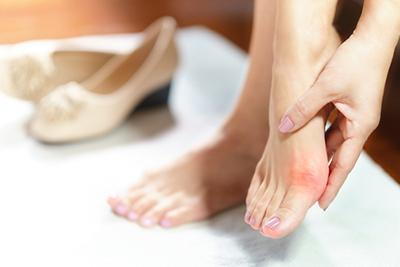
Bunions are bony bumps developing on the joint at the base of the big toe. They form when the big toe is pushed against the other toes, causing the joint to protrude outward. This pressure often leads to pain, swelling, redness, and limited toe mobility. Bunions can be caused by various factors, including genetics, wearing tight shoes, and certain foot deformities.
Anyone can develop bunions, but they're more common in women and often have a genetic component. People who wear ill-fitting shoes, such as high heels or narrow-toed shoes, are at a higher risk of developing bunions.
You should see an experienced podiatrist like Dr. Amberly Paradoa, Dr. Timothy Caballes, or Dr. Robby Caballes at Advanced Foot and Ankle of Indian River in Vero Beach, FL if you have persistent bunion pain, discomfort, or difficulty walking. Timely assessment and intervention by these skilled professionals can help alleviate pain and prevent bunions from worsening, ensuring the best foot health and quality of life possible.
What Causes Bunions?
Bunions develop from a combination of genetic predisposition and external factors. Your genetic makeup can play a significant role in determining whether you are prone to developing bunions. If your parents or grandparents had bunions, you may be more likely to experience them.
The primary culprit behind bunions is improper footwear. Wearing tight, narrow shoes or high heels can force your toes into unnatural positions, squeezing them together.
Over time, this constant pressure can push the base of your big toe outward, causing it to deviate toward the smaller toes. This misalignment creates a bony protrusion on the inside of your foot, known as a bunion. Certain medical conditions like arthritis and inflammatory joint diseases can also increase your susceptibility to bunions. These conditions can weaken the joint's stability, making it easier for a bunion to develop.
Bunions: Diagnosis and Treatment
Diagnosis of bunions involves a thorough examination by our podiatrist. Our doctor will assess your medical history, ask about your symptoms, and physically examine your foot. They may also order X-rays to determine the severity of the bunion and associated joint damage. These images help your healthcare provider make an accurate diagnosis.
Once diagnosed, bunion treatment varies depending on the severity of your condition. In mild cases, lifestyle modifications can be effective. Our doctor may recommend wearing wider, more comfortable shoes with good arch support and cushioning to relieve pressure on the affected area. Custom orthotic shoe inserts may also help distribute weight more evenly.
Please explore our website to learn about the conditions we treat and the services provided. For questions or concerns regarding the diagnosis, prevention, and treatment of bunions in Vero Beach, FL, consider an appointment with Dr. Amberly C. Paradoa, Dr. Timothy Caballes, or Dr. Robby Caballes at one of our two convenient Advanced Foot and Ankle of Indian River locations in Vero Beach, and Sebastian, FL. You can reach both offices by calling (772) 299-7009.
